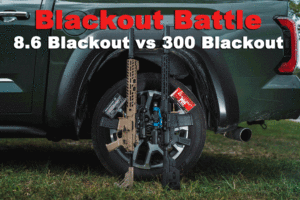[[{“value”:”
Thank you for reading this post, don't forget to follow and signup for notifications!
A side by side comparison of 8.6 Blackout vs 300 Blackout with range testing and real-world chronograph data.
The .300 AAC Blackout, commonly called the “.300 Blackout” and stylized as the “.300 BLK,” burst onto the shooting scene in 2010. Made for military purposes including special operations, the round was made with a heavy, hard-hitting bullet and could be dialed back for subsonic shooting.
It was an effective military round and became a popular option for American shooters who appreciate subsonic target shooting and hunting.
Now there’s a new “Blackout” on the market: the 8.6 Blackout.
Wider than the .300, it uses a case from the 6.5 Creedmoor and can be utilized in both bolt-action rifles and AR-10 platforms. While the .300 AAC Blackout performs well as a subsonic round, this one was optimized specifically for subsonic shooting.
You’ve got a Blackout in mind, which should you choose? Which offers the right energy and velocity for your unique needs? Which is most consumer friendly? Is one “better” than the other? To find out, we need to take a deep dive into the 8.6 Blackout vs the .300 Blackout.
The Short Answer: 300 BLK vs 8.6 BLK
The 8.6 Blackout cartridge is significantly larger than the 300 Blackout. While both rounds are designed for subsonic shooting, you’ll get more energy downrange with the 8.6 BLK. The 300 Blackout is typically cheaper to shoot and is frequently found in AR-15 platforms while the larger 8.6 is found in AR-10s.
8.6 Blackout vs .300 Blackout: Specs
| 8.6 Blackout | .300 AAC Blackout | |
|---|---|---|
| Bullet Diameter | 0.338 inches | 0.308 inches |
| Neck Diameter | 0.370 inches | 0.334 inches |
| Base Diameter | 0.4703 inches | 0.376 inches |
| Case Length | 1.685 inches | 1.36 inches |
| Overall Length | 2.825 inches | 2.26 inches |
| Bullet Weights | 210 – 342 grains | 110 – 260 grains |
| Typical Firearm | AR-10 rifles | AR-15 rifles |
Physical Differences
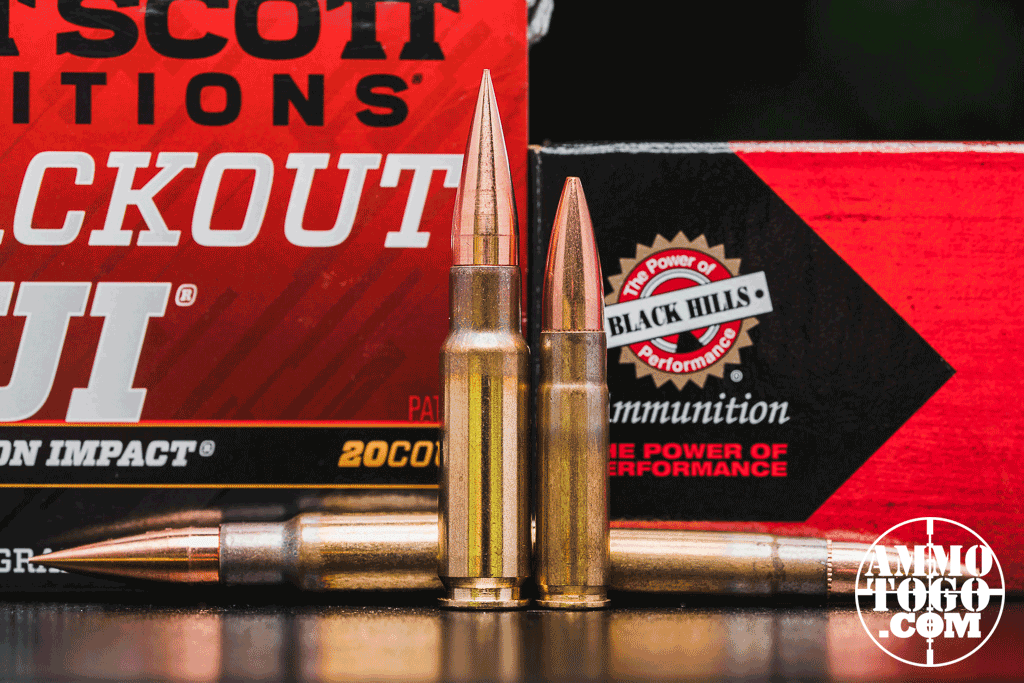
These two rounds are surprisingly similar, but there are important differences. Probably the most notable is the bullet diameter; the 8.6 is wider. It’s not a massive difference, but for a bullet, especially an expanding round, it can be significant. After all, whenever possible hunters typically prefer a wider wound channel.
The 8.6 is bigger in many areas, not just bullet diameter. It has a longer, wider case, a greater overall length, and heavier bullets. For these reasons, it’s often called the .300 Blackout’s big brother. (Bigger, but at the same time younger.)
The Ammo Market
Simple market conditions often drive ammo and rifle choices. The .300 AAC Blackout, at least currently, has more market support than the 8.6 Blackout. The .300 has been on the market since 2010 and has gained a loyal and dedicated fanbase. The 8.6 is a new arrival, and like all ammo newcomers, it hasn’t been adopted by major players in the industry. If it gains popularity, the big manufacturers like Federal, Remington, and Hornady may adopt this round; as of now it’s relatively obscure. 300 Blackout ammo is generally about in-line with the price of rifle calibers but it’s generally priced much cheaper than 8.6 BLK ammunition.
AR-10 vs AR-15 Platforms
If you already own an AR-15 or an AR-10, the decision may be easy. The 8.6 Blackout is fired from a converted AR-10; all you need is the appropriate upper and your rifle is now equipped for the 8.6. The same goes for the AR-15 and .300 Blackout; a new upper unit and you’re converted. So if you own one or the other, you may simply adopt the round that fits your rifle.
8.6 Blackout vs. 300 BLK: Ballistics
Velocity
| Ammo | Muzzle Velocity (fps) | 100-Yards | 200-Yards |
|---|---|---|---|
| 8.6 BLK – Callaway 285 Gr. ELD-M | 992 | 969 | 948 |
| 8.6 BLK – Dirty Bird 300 Gr. SMK | 1,007 | 980 | 956 |
| 8.6 BLK – Fort Scott 285-Gr. TUI | 1,050 | 1,018 | 990 |
| 8.6 BLK Average | 1,256 | 969 | 948 |
| 300 BLK – Remington 220-Gr. Subsonic | 940 | 917 | 896 |
| 300 BLK – Sellier & Bellot 200-Gr. FMJ | 1,060 | 1,013 | 977 |
| 300 BLK – Federal 150 Gr. Power-Shok | 1,900 | 1,685 | 1,490 |
| 300 BLK – Hornady 110 Gr. CX-Custom | 2,285 | 2,029 | 1,791 |
| 300 BLK Average | 1,546 | 1,411 | 1,289 |
Considering that these two rounds were specifically made for subsonic shooting, it’s no surprise that they don’t have overwhelming speed. About 1,000 feet-per-second (fps) is the typical muzzle velocity for both.
However, when the bullet is lightened, there is potential for decent speed. The 110-grain .300 BLK, the 150-grain .300 BLK, and the 210-grain 8.6 BLK are all near or above 2,000 fps.
Overall, the speeds are nearly identical. Honestly, speed is not typically a priority for people who adopt these rounds. Energy is far more important.
Real World Velocity Data
| 8.6 Blackout | SHOT 1 | SHOT 2 | SHOT 3 | AVERAGE |
|---|---|---|---|---|
| Fort Scott 235 Grain | 1,680 FPS | 1,649 FPS | 1,641 FPS | 1,656 FPS |
| Fort Scott 235 Gr Suppressed | 1.639 FPS | 1.670 FPS | 1,46 FPS | 1,652 FPS |
| Fort Scott 285 Gr | 1,119 FPS | 1,115 FPS | 1,113 FPS | 1,115 FPS |
| Fort Scott 285 Gr Suppressed | 1,106 FPS | 1,099 FPS | 1,108 FPS | 1,104 FPS |
| Gorilla Ammo 342 Gr | 1,090 FPS | 1,086 FPS | 1,088 FPS | 1,088 FPS |
| Gorilla Ammo 342 Gr Suppressed | 1,081 FPS | 1,071 FPS | 1,061 FPS | 1,071 FPS |
| 300 Blackout | ||||
| Sellier & Bellot 147 Gr | 2,085 FPS | 2,063 FPS | 2,098 FPS | 2,082 FPS |
| Sellier & Bellot 147gr Suppressed | 2,048 FPS | 2,021 FPS | 2,028 FPS | 2,032 FPS |
| Winchester Subsonic 200 Gr | 1,383 FPS | 1,356 FPS | 1,343 FPS | 1,360 FPS |
| Winchester 200gr Suppressed | 1,329 FPS | 1,312 FPS | 1,317 FPS | 1,319 FPS |
| 1,350 FPS | 1,336 FPS | 1,321 FPS | 1,335 FPS | |
| Black Hills 220 Gr Suppressed | 1,254 FPS | 1,240 FPS | 1,242 FPS | 1,245 FPS |
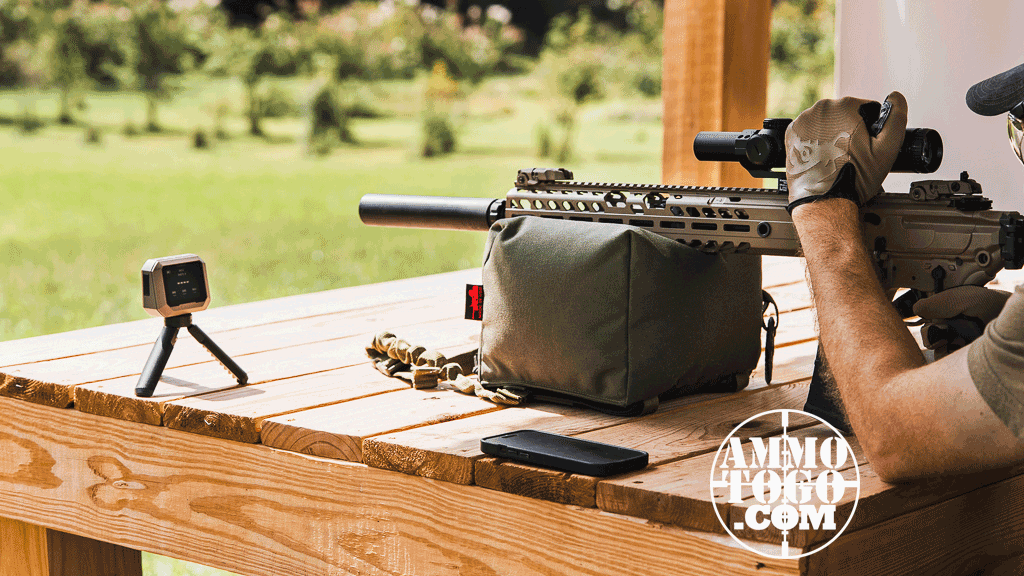
While ammo options for 8.6 Blackout are fairly limited, we did get some real world testing data with our Faxon FF-10XRS rifle with 16″ barrel. For our 300 Blackout data, we fired a Sig Sauer MCX Virtus with a 16″ barrel as well.
We also incorporated suppressors into our testing. For the 300 Blackout, we used a Sylvan Arms SA30TI .30 Cal 8″ can. For the 8.6 BLK, we used a Dead Air Primal .458 Cal 8″ suppressor.
While not exhaustive, we find the real world data collected with rifles more commonly used in the field beneficial in addition to the manufacturer data. You can find more manufacturer 300 Blackout ballistics data here. See more ballistic tables for 8.6 Blackout here.
Energy Comparison
| Ammo | Muzzle Energy (ft-lbs) | 100-Yards | 200-Yards |
|---|---|---|---|
| 8.6 BLK – Callaway 285 Gr. ELD-M | 623 | 594 | 568 |
| 8.6 BLK – Dirty Bird 300 Gr. SMK | 675 | 640 | 609 |
| 8.6 BLK – Fort Scott 285-Gr. TUI | 698 | 656 | 620 |
| 8.6 BLK – Gorilla 210 Gr. TSX | 1,810 | 1,491 | 1,222 |
| 8.6 BLK Average | 952 | 845 | 756 |
| 300 BLK – Remington 220-Gr. Subsonic | 432 | 411 | 392 |
| 300 BLK – Sellier & Bellot 200-Gr. FMJ | 499 | 456 | 424 |
| 300 BLK – Federal 150 Gr. Power-Shok | 1,202 | 946 | 739 |
| 300 BLK – Hornady 110 Gr. CX-Custom | 1,275 | 1,005 | 784 |
| 300 BLK Average | 852 | 705 | 584 |
Energy statistics are similar, but it appears the heavier 8.6 Blackout has a slight advantage. The heavier subsonic rounds deliver greater energies to the target, which suggests greater capability for harvesting deer, hog, and other medium-size game animals. (Of course, this depends on getting within range.)
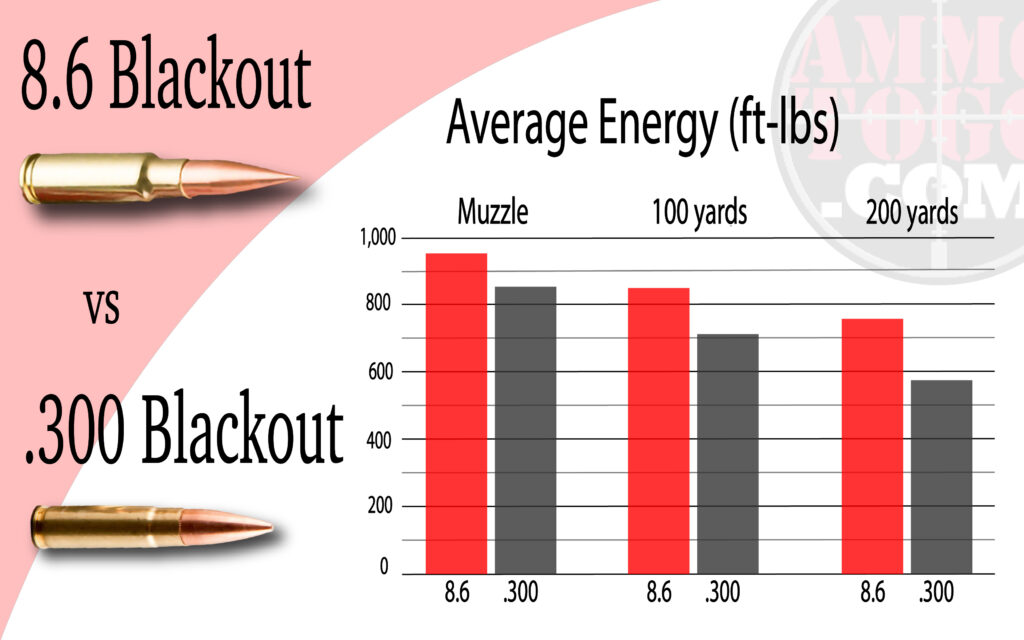
Again, there is some high-powered capability. The most powerful in this comparison is the 210-grain 8.6, which reaches above 1,800 ft-lbs.
Trajectory
| Ammo | Drop at 200 Yards (100 yd. zero) |
|---|---|
| 8.6 BLK – Callaway 285 Gr. ELD-M | 35.5 |
| 8.6 BLK – Dirty Bird 300 Gr. SMK | 34.7 |
| 8.6 BLK – Fort Scott 285. Gr. TUI | 32 |
| 8.6 BLK – Gorilla 210 Gr. TSX | 9.4 |
| 8.6 BLK – Gorilla 300 Gr. SMK | 32 |
| 8.6 BLK – Gorilla 285 Gr. Facturing | 32.1 |
| 8.6 BLK – 342 Gr. Pork Shredder CHP | 35 |
| 8.6 BLK Average | 30.1 |
| 300 BLK – Winchester 125 Gr. USA Ready | 7 |
| 300 BLK – Federal 150 Gr. Power-Shok | 10.8 |
| 300 BLK – Sellier & Bellot 200 Gr. FMJ | 39.8 |
| 300 BLK – Remington 220 Gr. Subsonic | 31.8 |
| 300 BLK Average | 27.5 |
Note: We inserted the 125-grain product from Winchester because it has data consistent with the other cartridges used in our energy and velocity tables.
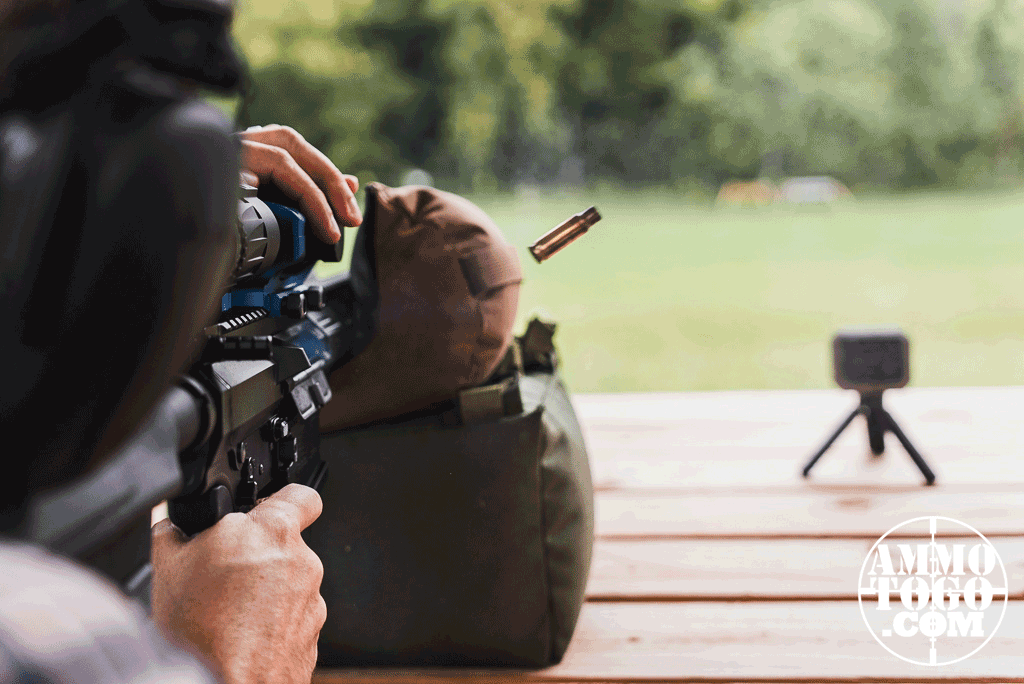
Neither of these rounds will be considered a long-range cartridge. While they hold a reliable trajectory within 100 yards, many plummet over two and a half feet between 100 yards and 200 yards. Experienced shooters can adjust, but that’s a large drop between the muzzle and the 200-yard mark.

Again, if reaching 200 yards is a priority, there is potential with the lighter options. The 150-grain .300 BLK and the 210-grain 8.6 drop about 10 inches, but you’ll lose subsonic capability with these products.
8.6 Blackout vs .300 Blackout: Making the Choice
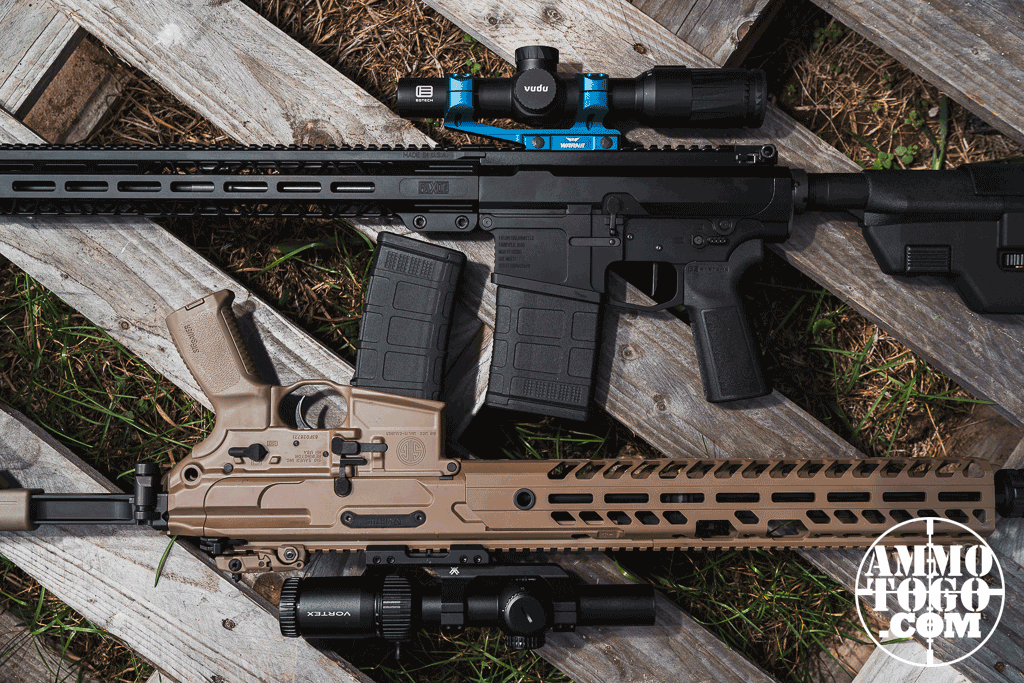
Both of these rounds offer subsonic shooting with reliable capability within 100 to 150 yards. Choosing one of the other may seem difficult, but it can be fairly easy if you consider your goals and current firearms collection.
First of all, if you have either an AR-10 or an AR-15, you may choose based on the platform. The 8.6 is for the AR-10, the .300 is for the AR-15, so your choice may be decided regardless of the ballistic stats.
If you want more energy from a subsonic cartridge, the 8.6 is the better choice. You’ll get an increase of about 100 to 200 ft-lbs in muzzle energy, which can make a big difference when energies are already low.
However, if you want a more market-friendly cartridge, the .300 Blackout, which has had time to mature as a consumer product, will be a more diverse, readily available, and affordable option.
Whether you adopt the 8.6 Blackout or the .300 Blackout, you’ll find the affordable rounds you need at ammotogo.com!
“}]]


